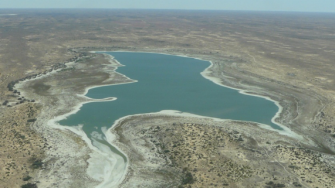
Date: Wednesday, October 14, 2015
Project: Eastern Australian Waterbird Survey
Observer: Terry Korn
A newly washed Cunnamulla greeted us as the day dawned with a sparkling sky to take us west into the Strzelecki Desert to count Lake Kilalapanina just east of Lake Eyre. A very early drive to the Cunnamulla airport was hazardous because of the large numbers of western grey kangaroos out celebrating the storm rain of the previous evening. Three of them had breached the airport chain mesh fence and needed to be removed for safety.
Between Cunnamulla and the Bulloo River, dry clay pans and dry cane grass swamps dominated our counting. The first water we found was in the Bulloo River and the terminal Bulloo Lakes system, home of the famous Bulloo Downs station. Despite this being the only large body of water for hundreds of kilometres, Bulloo Lake was surprisingly not pulsing with waterbirds as often happens on such lakes. There were good numbers of pink-eared ducks and grey teal. A very shallow mud flat was feeding a couple of hundred small waders on their way south for the Australian summer.
Bulloo Lake is a terminal lake of the Bulloo River. Large lignum stands surround the lake. Photo: Terry Korn
A short refuelling break was taken at Innamincka where we noted housing blocks were for sale in a new subdivision – growth in the outback. The Strzelecki Desert then beckoned where Santos has its Moomba facility. The desert is criss-crossed with maintenance tracks which service the wells. The isolated facility looks like something from a Mad Max movie.
Cooper’s Creek snakes through the Strzelecki desert towards Lake Eyre. Photo: Terry Korn
Lake Kalapaninna was not a disappointment following the 65 minute flight from Innamincka. There was thousands of pink-eared ducks and grey teal plus hundreds of red-necked avocets. Interestingly there was also a group of Australian Shelduck.
Lake Kilalpaninna is one of the few remote desert salt lakes holding water. Photo: Terry Korn
A two hour flight over desert dunes and Lake Gregory took us to the NSW/SA border at Starvation Lake at the western end of Band 5. Between the border fence and the Broken Hill road our navigation, counting and recording skills were tested as we moved swiftly from one small wetland to another. These were filled with good rains in December /January. Their shallow waters were highly productive, attracting large numbers of waterbirds, including pink-eared ducks, grey teal, Pacific black duck, avocets and coot.
After a 6.30 am departure from Cunnamulla, we were happy to land at 4pm to spend the night at White Cliffs. We arrived as the interdisciplinary Flying Doctor team from Broken Hill consisting of doctors, nurses, dentists and physiotherapists was just departing after its weekly visit.
